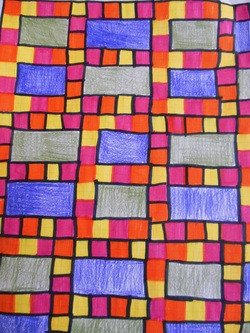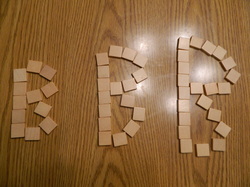This semester's group got pretty into it: the story of Gillian Lynne was high impact, the idea that things need to change had traction, several recognized that they had been subject to this, and the desire to incorporate movement really resonated. (We have a drummer in class, so that might happen.) Some students wrote about creativity for their weekly work: Lauren and Kyrstin, for example.
One of the ways I'm trying to encourage creativity is a work structure (syllabus) like this:
Daily Work: I’m asking you for 1 hour per class. Document what you did somehow and keep in a binder. It is not evaluated on correctness, but on percent completed. Keep an index/table of contents for which days you have work for. This work should either be doing math or learning about the teaching of math. It is okay to double dip - use daily time for Family Math or weekly work. Just keep track of getting in your hours. I will offer suggestions, but this is your responsibility. It’s a good opportunity to practice generating ways to meaningfully work, which will be an important part of your work as a teacher.There's a urli.st of their weekly blogs The list helps me in finding them all for giving feedback, but I ask them to link posts to our Facebook group as well. That gets more readership amongst the class than I've ever had before. One of the purposes of blogging their work is to increase their sense of audience. So if you do take a peek, please comment!
Creating: from our work each week I am asking you to put an additional hour or two into deeper work of your choice. Revise or extend a daily work, play or make a math game, make some math art, find and read something in an area of interest, work on a math problem of interest or create a mathematical task… there is so much different work that teachers do. If you can connect it to our course work, it’s probably okay. Each week’s work will get feedback in terms of our rubric and qualitative. But those aren’t grades. At the end of the semester this weekly work will be evaluated ⅓ on completion (did you complete work for each week) and ⅔ on exemplars. You will pick two examplars of your doing math, and two examples of your preparing to teach math.
The math content we paired with this is patterning. Our first activity (close to this previously blogged one) got us playing with the appropriately named pattern blocks, trying to get at the idea of what makes a pattern a pattern instead of a design. Our ultimate idea was that it needs to be extendable. Not necessarily predictable, but when you see what comes next it should make sense with what came before. They built and then we talked about repeating patterns and growing patterns and then sequential patterns. To emphasize the extendable idea, we built patterns, then rotated to have someone else add on. Clearly - time for pictures.
 |
| Clear to everyone |
 |
| No discussion |
 |
| People accepted extension, but felt like 3rd red block could go "anywhere" |
 |
| Generated interest because the start was in a line, and the pattern was extended 2-dimensionally |
 |
| Patter creator admitted they didn't know what came next, but liked the extension. Next: 3 blues top and bottom. |
 |
| Arguments! Pattern creator wanted the trapezoids double each step, extender focused on blues "adding one" each time. |
 |
| Is this a pattern? Designer claimed it was just a design. Extender felt like the red-blue-green were lines extending out each direction. All agreed: lovely! |
The next day I wanted to build on the idea of the sequential growing patterns with explicit connections to algebra. My colleague Pam Wells has the best activity I know for this, adapted from a Mathscape activity. Here's my version. (As a Word doc, if you want to edit. Wasn't displaying correctly...)
Everytime I've used it the lesson has been engaging, provoking discussion, and very supportive of symbolic representation with the visual. Students wanted to work through all the letters on the front, though I only asked them to pick a couple. Many wanted to jump to building their own pattern immediately. Most glossed over the verbal description, so I pushed for that. In general with our pattern work, visual to verbal has been uncomfortable. This is a good activity for the connection between rate of change and the symbolic rule, as several students made that jump. Some students went from data to rule, and some from the visual.
 A couple students extended this for their weekly work. I based my sample weekly work on the letter patterns, so I expected more, actually; but that's why we give students choice. Brett extended the letter idea to his whole name, which is actually a pretty nice context for adding functions. (File that one away!) Emily did a really interesting project, making some mathart that had layers of patterns.
A couple students extended this for their weekly work. I based my sample weekly work on the letter patterns, so I expected more, actually; but that's why we give students choice. Brett extended the letter idea to his whole name, which is actually a pretty nice context for adding functions. (File that one away!) Emily did a really interesting project, making some mathart that had layers of patterns.The lesson after this was dominoes - but that's clearly a story for another day. Later in the semester we'll do more patterns using ideas of perimeter, area and volume.






No comments:
Post a Comment